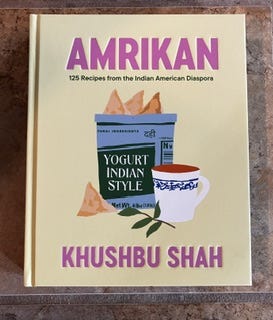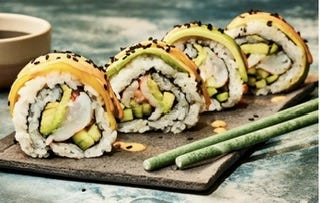We're Seeing A New Kind Of International Cookbook
Diaspora recipes are joining traditional approaches
Happy Mother’s Day! Wishing all the best to the mothers and mother figures in the CulinaryWoman audience. I hope you’ll be properly pampered. A warm hug to readers whose mothers are no longer with us. I think of my mother every day.
Welcome to new readers, and special thanks to everyone else. CulinaryWoman is about to turn four years old and I would not be here without your support. I love bringing you news from the ever-changing culinary world, and I’ve noticed a new trend when it comes to cookbooks.
Re-Interpreting International Recipes For A New Generation
A few days ago, I opened a heavy brown box from W.W. Norton, which has published some of my favorite cookbooks. Inside was a copy of Amrikan, by Khushbu Shah which will come out on June 4. (That’s an easy date for me to remember, because it is the birthday of my best friend growing up.)
Along with its colorful cover, the book’s secondary headline, which we call a “deck” in the newspaper business, caught my eye. “125 Recipes From the Indian American Diaspora,” it read. The press release for the book explained that Khushbu set out to explore Indian food in America.
While there is recipe for that familiar staple, Butter Chicken, the cookbook goes far beyond the classics. It includes dishes such as Saag Paneer Lasagna, Keralan Fried Chicken Sandwiches, Pani Puri Mojitos, and a Masala Chai Basque Cheesecake.
Her book struck a chord with me, because it is echoing an approach is emerging in cookbooks: first and second generation chefs taking their ancestors’ ways of preparing dishes, and updating them to fit modern, American tastes.
Seeing it right after I heard Eric Kim and Matt Rodbard talk about their books — Korean-American and Koreaworld, respectively - at Miss Kim made me think that a trend was taking hold.
What is really authentic?
You can argue that Julia Child did something similar with Mastering The Art of French Cooking. She was interpreting often-intimidating French recipes for American housewives, whose access to ingredients was not the same as Julia found in Paris and Marseilles. Rick Bayless, who grew up in Oklahoma, has gone in that direction with his many books on Mexican cuisine.
But there’s a difference between those authors and the current writers, says Kevin Pang, the writer and filmmaker whose book you heard about here a few months ago.
Kevin and his father Jeffrey co-wrote A Very Chinese Cookbook: 100 Recipes From China And Not China (But Still Rreally Chinese, which has received warm reviews, and he notes that the new writers are often immigrants, like the Pangs.
“While many of us respect those recipe traditions from the motherland, we also know that dishes are living, breathing organisms,” Kevin told me. “They evolve and transmogrify in a new host.”
Using a music analogy, he likened the adaptations to rock and roll. “It came from a place like Memphis and traveled overseas to Liverpool, where it became something else entirely, a music just as valid,” Kevin said.
Food is the same way. “I really hate the term ‘authentic,’ because Almond Boneless Chicken is every bit authentic to an American Chinese growing up in Detroit, as Soy Sauce Chicken is to someone from Hong Kong.”
He’s right. I ate lots of Almond Boneless Chicken (which we nicknamed “ABC”) growing up, and even got to taste the original version at Chung’s in Detroit before it closed. The first time I tried Soy Sauce Chicken at Ollie’s Noodles in New York City, it was a completely different dining experience.
Fusion Cuisine With Universal Appeal
One of the things I enjoyed most about living in Tokyo was getting to try Japanese food where it originated, what cooks call “terroir.” While Americans in many cities have been eating sushi for nearly a half century, Japanese food here has evolved way beyond the simple dishes that were best known back in Japan.
I lived on the border of two bustling neighborhoods: Roppongi, which is best known for hotels, shopping and nightclubs, and Azuba Juban, which was home to many non-Japanese residents.
I loved walking down the main shopping street in Azuba and popping into little shops and fascinating convenience stores, where you could get fresh edimame, sushi rolls and noodle dishes for just a few dollars.
One day, I noticed that a new sushi restaurant had opened, with the added appeal of an outdoor terrace. We went over to check it out and found that the menu departed widely from the sushi we’d been sampling in the small places.
The lineup included elaborate looking rolls with multiple ingredients, the kind you find at Japanese restaurants surrounding college campuses.
I chatted with the owner, who told me that there was an increasing demand for this “American sushi,” as he dubbed it.
Even though Japanese diners could easily access the original and often exquisite versions of their cuisine, younger people were especially interested in how it had been updated overseas.
As social media spreads ideas in the blink of an eye, you can expect even more riffs from people taking the food they grew up with and creating entirely new melodies.
Friendly’s Restaurants Are Making A Comeback
Many of us grew up getting quick meals and ice cream at Friendly’s, the New England-based chain. (My favorite was raspberry sherbet with jimmies, aka chocolate sprinkles.)
But in recent years, the number of Friendly’s has dwindled from 425 at its peak, to just 104. There have been two bankruptcy filings, and Friendly’s all but disappeared from its original stomping ground.
Now, however, Friendly’s are reappearing. It recently opened a new location in Orlando, Florida, where one of its classic restaurants has hung on. This Friendly’s has a retro look but an updated menu.
The shop is not far from Walt Disney World, so you can walk your feet off and go get a Fribble after you leave the park.
What Did They Eat At The Met Gala?
For fashionistas and people who love costumes, the Met Gala has become the biggest night of the year, eclipsing any awards show red carpet. Once the attendees climb the iconic stairs, however, their thoughts turn to dinner.
The menu always has a tie-in with the latest exhibit from the Metropolitan Museum’s costume institute. Last year, guests were served Diet Coke, the favorite beverage of honoree Karl Lagerfeld.
This year’s theme, “Sleeping Beauty: Awakening Fashion” brought a lineup that echoed a children’s storybook, according to Vogue, whose editor, Anna Wintour, helms the dinner.
Caterer Oliver Cheng was in charge of the menu, which included
Appetizer: spring vegetable salad with elderflower foam, raspberry vinaigrette, and olive crumble that resembled soil, complete with butterfly-shaped croutons.
Main course: a filet of beef topped with a tortellini rose.
Dessert: almond cremeux molded into the shape of a miniature apple, blanketed with a bright red mirror glaze, and placed it on a walnut-flavored ‘leaf.’
A Special Offer For CulinaryWoman Readers
I recently received a box of snacks from Confetti, a company based in Singapore that specializes in dried vegetables and fruit.
Their newest product is Crunchy Mandarin Oranges. They are dried mandarin orange pieces. That’s it. You open the bag, and see dried orange segments, which are the cutest things ever.
The oranges come in two flavors, Just Half Moons, and Holiday Spice. Just Half Moons are plain, while Holiday Spice has Cinnamon, Nutmeg, Star Aniise, and Cocoa Powder.
On first bite, the Just Half Moons seemed just a little sour, reminiscent of a sour ball candy. But as I ate more of them, I found the flavor and the crunch to be satisfying. An entire bag has 210 calories (they’re 70 calories per serving).
Confetti also sent me samples of their dried mushroom and veggie chip snacks. The mushrooms are actual mushrooms, shrunken down and flavored, which make them fun to eat. The veggie chips included red and green radishes, carrots, okra, shitake mushrooms and purple sweet potato.
Confetti is extending a special offer to CulinaryWoman readers. On their website, use the promo code ConfettiMandarins15.
That provides a 15% discount for a case of 12 pouches, which is normally $60. They will deliver to any zip code in America within 3-5 business days. (You can buy an individual bag for $5.99 without the discount, and go back for a case if you decide you like them.)
I could see packing them in my computer bag and taking them along on business trips. They’d also be a good snack to keep in the car, since they’re dried and won’t spoil.
Let me know if you order some and what you think of them.
Keeping Up With CulinaryWoman
I wrote a story about an intriguing court ruling for Food & Wine. Five years ago, a Pennsylvania woman noticed that she’d been charged 24 cents in sales tax on a bottle of Perrier. The French company has long advertised its product as naturally occurring sparkling water.
She filed a class action lawsuit contending she’d been wrongly charged, since state law considers water to be tax free. Her suit revealed some things you might not know about Perrier.
While the bubbles and the water come out of the ground, they aren’t bottled directly from the source. They are separated, the water is cleaned, and the two substances are re-combined. But that’s not all: Perrier enhances the carbonation from an external source. Read more in my story.
Meanwhile, anyone who ever worked on Mother’s Day will not be surprised to learn that it’s the single biggest Sunday of the year for restaurants. Lots of great numbers in my piece for Food & Wine.
Thank you so much to the public library in Fraser, Mich., for hosting me on Saturday. I enjoyed the audience questions and it was fun to meet fans of Zingerman’s.
I’d be happy to hear from you. This is how to reach me.
Website: www.michelinemaynard.com
Email: culinarywoman (@) gmail dot com
LinkedIn: Micheline Maynard
Threads and Instagram: (@) michelinemaynard
Etsy shop: City Tips Vintage
I’ll be back tomorrow with Red Beans & Advice for our paid subscribers, talking about the ways you can land reservations at hot restaurants - and conversely, how to boost struggling restaurants this summer.











